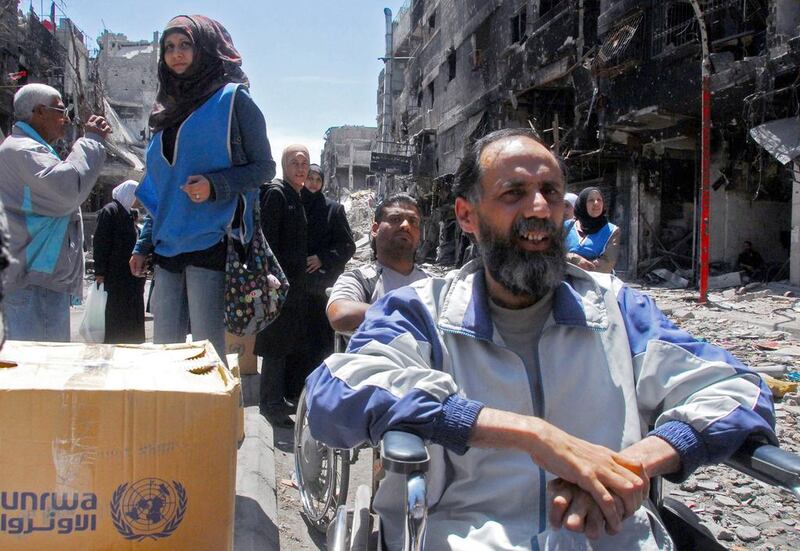Beirut // After a two-week halt, food has once again begun to trickle into the besieged Damascus neighbourhood of Yarmouk but supplies fall far short of what is needed to feed thousands of trapped civilians, according to aid officials.
For five hours on Friday and two-and-a-half hours on Thursday, the UN was allowed access to the labyrinth-like district in the Syrian capital’s southern suburbs, just enough time to deliver food parcels for 732 families, or approximately 3,660 people.
There are 18,000 civilians in Yarmouk and a UN parcel can feed a family of five people for 10 days.
“It’s not enough,” said Chris Gunness, a spokesman for UNRWA, the United Nations agency overseeing the relief effort in Yarmouk, of the latest aid drop.
“Demand for food is overwhelming. There are widespread reports of children with malnutrition, of people eating animal feed. It is beyond desperate,” he said.
According to Amnesty International, at least 128 people have died of starvation in Yarmouk since forces loyal to President Bashar Al Assad tightened a siege in July last year.
“People are still at risk of malnutrition and starvation, which is why we need regular, sustained and substantial access,” Mr Gunness said, stressing UNRWA’s willingness to work throughout “daylight hours, seven days a week” to get medicine and food into Yarmouk.
Supplies are only allowed in with express permission of the Syrian authorities.
“It is particularly vital that UNRWA is permitted to increase the duration and scale of distributions in Yarmouk on a continuous, daily basis,” Mr Gunness said.
On February 22 , the UN Security Council passed resolution 2139, demanding the Syrian government and rebels give unfettered access for humanitarian aid, including food and medical supplies, in all parts of the country.
That was more than 60 days ago. Since then, the UN has been able to deliver 5,115 food parcels to Yarmouk, enough to feed the trapped population for about 10 days.
“The Syrian authorities are deliberately stifling the aid effort; they want to let in enough food to get the international community off their backs and claim they are meeting resolution 2139, but not enough to actually feed people – they consider Yarmouk rebel-held and their enemy,” said an aid worker familiar with relief efforts in the district.
In the two weeks before Thursday’s aid delivery, the Syrian authorities had closed Yarmouk off, shutting the main checkpoint at the northern tip of the district.
Syrian officials said “security concerns” prompted the renewed blockade. According to two aid workers close to the relief effort in Yarmouk, the authorities stopped deliveries amid allegations that a senior regime security officer had taken a large bribe to let in more food.
“We have been told a high ranking security official took a lot of money to let in more food than the regime wanted getting in. The details are not clear, but that seems to be the reason for the closure of the checkpoint two weeks ago, there has been a big investigation into it,” said an official with a western aid organisation, who spoke on condition of anonymity.
The claim could not be independently verified.
In the early months of the Syrian uprising, Yarmouk, largely inhabited by Palestinian refugees and low-ranking Syrian government functionaries, remained neutral. But, slowly, it got sucked into the revolution and, later, the wider conflict, with Palestinians joining both regime and rebels groups.
In June 2011, Palestinian residents in Yarmouk protested against some Palestinian political factions which had openly joined forces with Mr Al Assad. The Popular Front for the Liberation of Palestine General Command (PFLP-GC), the main pro-regime group in Yarmouk, responded to the peaceful protest by fatally shooting 12 unarmed demonstrators, further inflaming tensions.
As Syrians displaced from nearby neighbourhoods, such as Hajar Aswad and Tadamon, sought refuge in Yarmouk, pro-regime militias began to take command of the streets and used it to stage out attacks on rebels nearby.
That brought fighting directly into the camp, a situation that dramatically escalated in the summer of 2012, when rebel units launched an ill-fated assault on central Damascus. Telling residents they needed “a few days” to carry out the attack, rebel units took command of Yarmouk. They never left, and as Al Qaeda-affiliated Jabhat Al Nusra grew in prominence there, regime forces imposed a devastating blockade.
In February this year, negotiations to end the siege saw Al Nusra agree to pull its fighters out of Yarmouk in exchange for an end to the blockafe. While regime forces did subsequently allow in more aid, it was tightly controlled and in small amounts, not the broader opening Al Nusra felt it had agreed to.
The rebel fighters returned, saying Damascus had reneged on the deal, and aid access was once more cut back. Rebels remain in Yarmouk.
“It is bad luck for the people of Yarmouk that both the regime and the rebels have decided it is a strategically important place, that it is a gate to Damascus, so both are prepared to fight to the last drop of our blood to win there,” said a former resident, now a refugee.
“No one will win there, and all of the civilians will lose. So much has already been destroyed there, most of what we knew has been turned to rubble,” he said.
psands@thenational.ae





